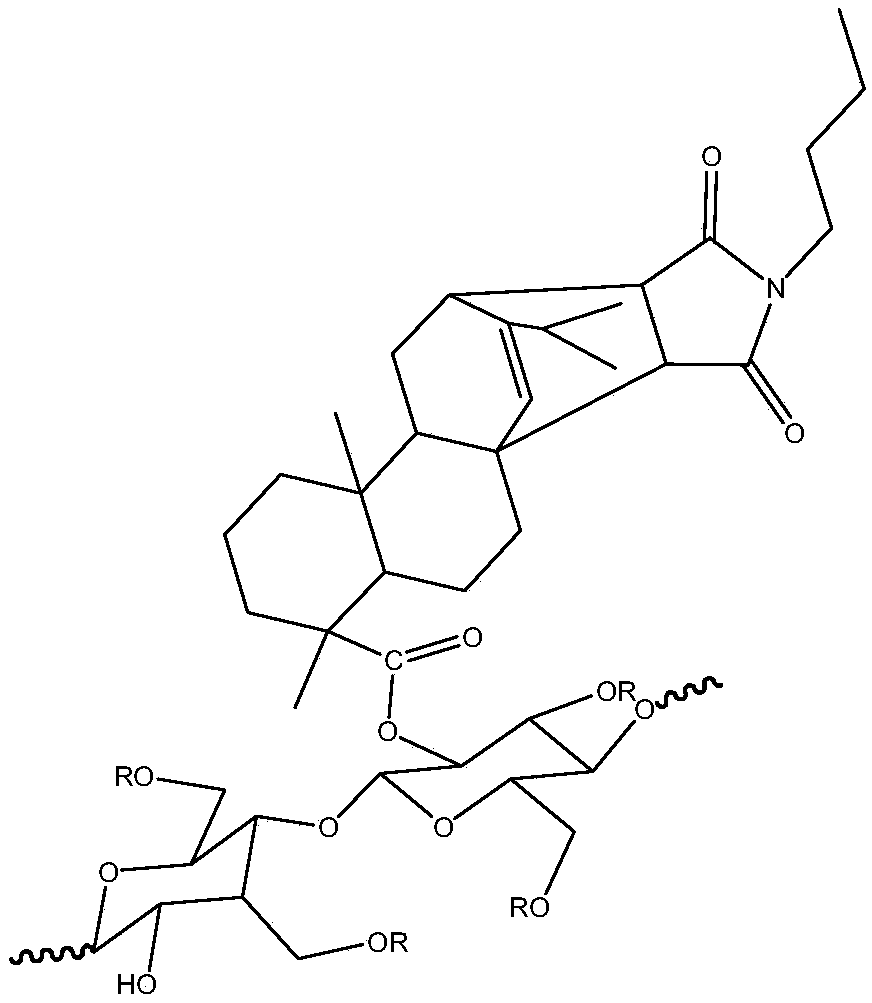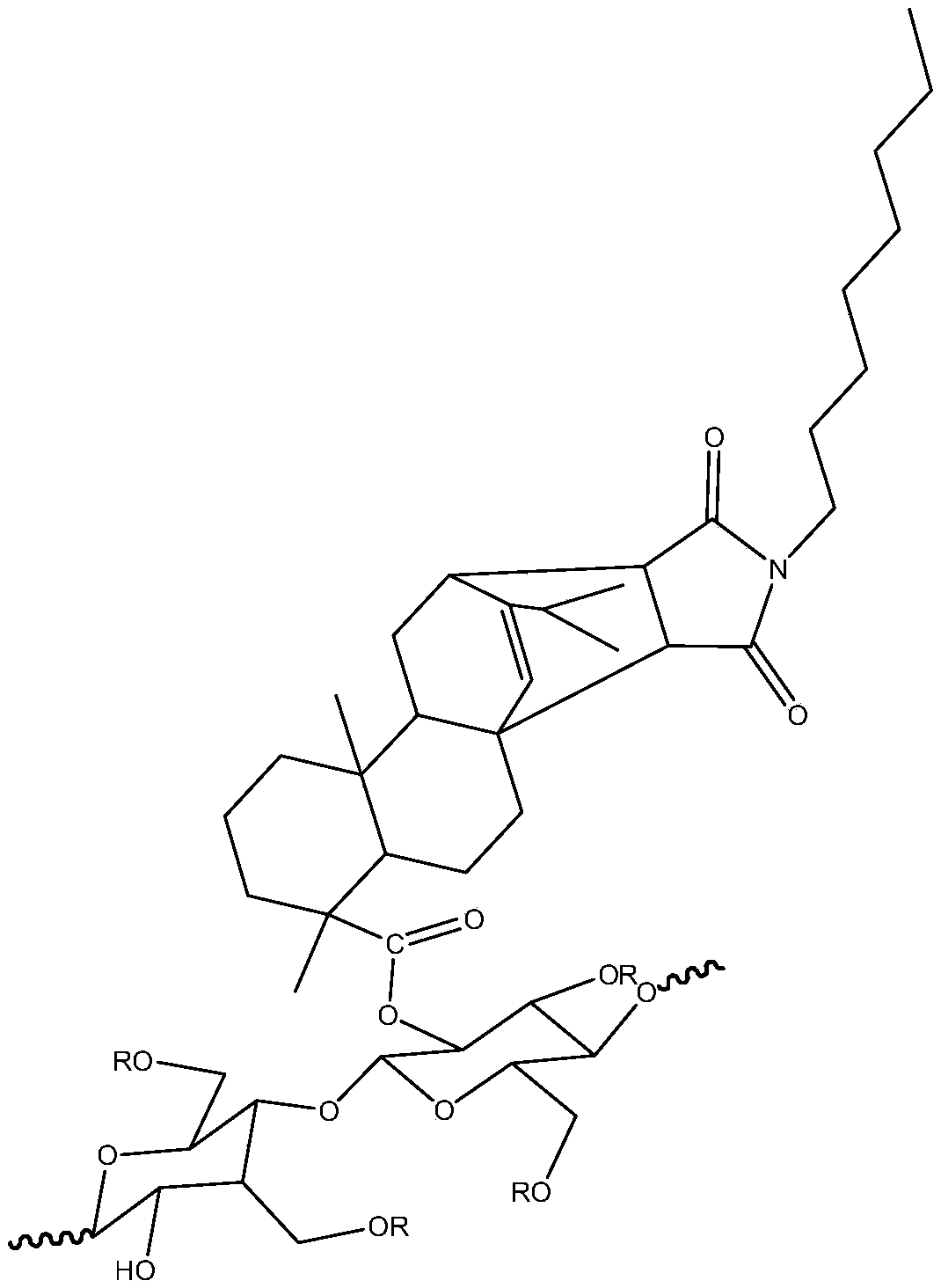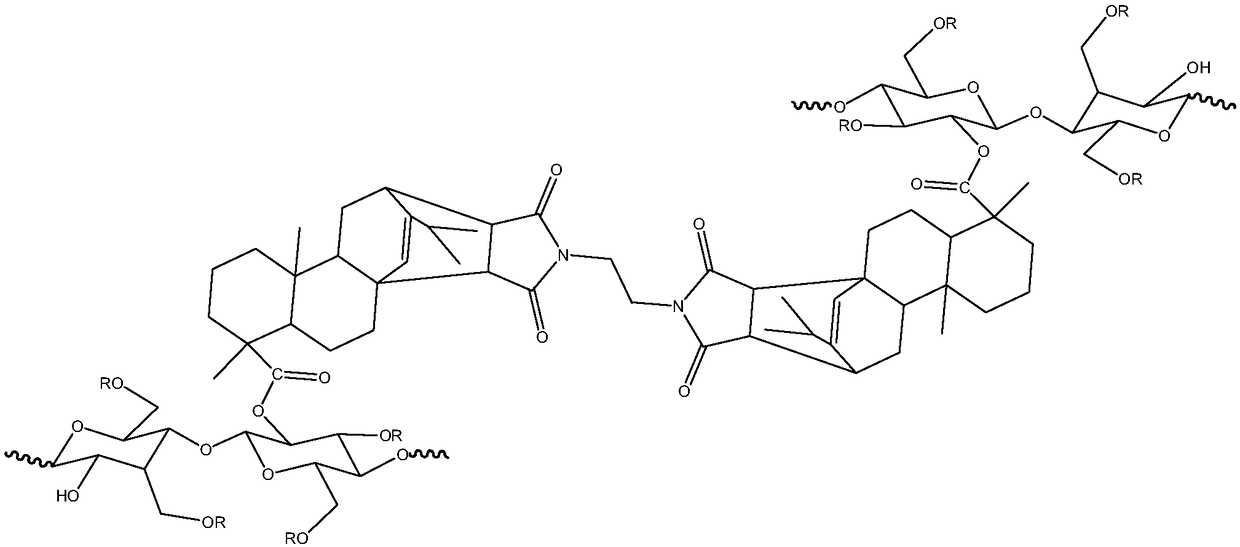Rosin-cellulose-based polyesterimide polymer, and preparation method and application thereof
A technology based on polyesterimide and cellulose, applied in the field of bio-based polymer amphiphilic polymer preparation
- Summary
- Abstract
- Description
- Claims
- Application Information
AI Technical Summary
Problems solved by technology
Method used
Image
Examples
Embodiment 1
[0029] In the first step, add 100g of gum rosin, 32.7g of maleic anhydride, 100g of glacial acetic acid, and 0.02g of p-toluenesulfonic acid into a 500mL four-neck flask, add them into the reactor, start stirring, and reflux at 120°C for 5 hours under nitrogen gas. After the product was cooled to room temperature, it was recrystallized three times with glacial acetic acid, and dried in vacuum at 120°C for 5 hours to obtain MPA;
[0030] In the second step, 26g MPA (0.065mol, about 1.3 times of EC) was dissolved in 40mL THF, and 7.2mL oxalyl chloride (0.0845mol, 10.7g) was added dropwise at 0°C, and reacted at 50°C for 2 hours (dropping A small amount of DMF, 0.35mL, about 5wt.% of MPA, passed through molecular sieves before use). Remove the reactant and evaporate to dryness at 50°C, then add 40mL THF, and evaporate to dryness; then add 40mL THF and evaporate to dryness to obtain the intermediate product MPACl;
[0031] In the third step, MPACl was dissolved in THF and dropped...
Embodiment 2
[0034] In the first step, add 100g of gum rosin, 32.7g of maleic anhydride, 100g of glacial acetic acid, and 0.02g of p-toluenesulfonic acid into a 500mL four-neck flask, start stirring, and reflux at 120°C for 5 hours under nitrogen, and cool the product to After room temperature, recrystallize three times with glacial acetic acid, and dry in vacuum at 120°C for 5 hours to obtain MPA;
[0035] In the second step, 26g MPA (0.065mol, about 1.3 times of EC) was dissolved in 40mL THF, and 7.2mL oxalyl chloride (0.0845mol, 10.7g) was added dropwise at 0-5°C, and reacted at 50°C for 2 hours ; (drop a small amount of DMF, 0.35mL, about 5wt.% of MPA, pass through molecular sieves before use). Remove the reactant and evaporate to dryness at 50°C, then add 40mL THF, and evaporate to dryness; then add 40mL THF and evaporate to dryness to obtain the intermediate product MPACl;
[0036] In the third step, MPACl was dissolved in THF and dropped into a flask containing 12.3g EC (0.05mol), ...
Embodiment 3
[0039] In the first step, add 100g of gum rosin, 32.7g of maleic anhydride, 100g of glacial acetic acid, and 0.02g of p-toluenesulfonic acid into a 500mL four-neck flask, start stirring, and reflux at 120°C for 5 hours under nitrogen, and cool the product to After room temperature, recrystallize three times with glacial acetic acid, and dry in vacuum at 120°C for 5 hours to obtain MPA;
[0040] In the second step, 26g of MPA (0.065mol, about 1.3 times of EC) was dissolved in 40mL of THF, and 7.2mL of oxalyl chloride (0.0845mol, 10.7g) was added dropwise at 0°C, and reacted at 50°C for 2 hours; ( Add a small amount of DMF, 0.35mL, about 5wt.% of MPA, pass through molecular sieves before use). Remove the reactant and evaporate to dryness at 50°C, then add 40mL THF, and evaporate to dryness; then add 40mL THF and evaporate to dryness to obtain the intermediate product MPACl;
[0041] In the third step, MPACl was dissolved in THF and dropped into a flask containing 12.3g EC (0.05...
PUM
 Login to View More
Login to View More Abstract
Description
Claims
Application Information
 Login to View More
Login to View More - R&D
- Intellectual Property
- Life Sciences
- Materials
- Tech Scout
- Unparalleled Data Quality
- Higher Quality Content
- 60% Fewer Hallucinations
Browse by: Latest US Patents, China's latest patents, Technical Efficacy Thesaurus, Application Domain, Technology Topic, Popular Technical Reports.
© 2025 PatSnap. All rights reserved.Legal|Privacy policy|Modern Slavery Act Transparency Statement|Sitemap|About US| Contact US: help@patsnap.com



